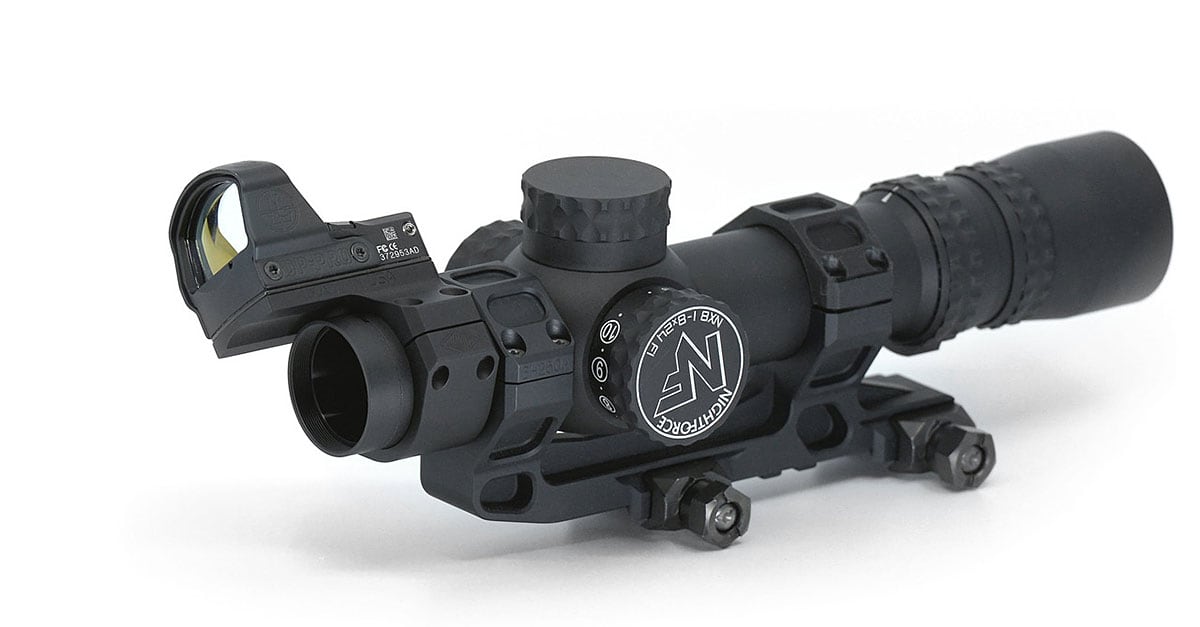Doctrine for addressing targets spanning short and long ranges is significantly expanding and options are diverging even in serious duty use. Some contend a LPVO with a true 1x is sufficient; folks in high-speed communities and in competition also use offset tube-style and MRDS on 1 o'clock, 33 deg, and 45 deg offsets on the rail. MRDS mounted to the top of ACOGS are old news but I am seeing increased innovation/application of scope-tube-mounts at different angles:
https://www.spuhr.biz/ideal-scope-mount-system (view pictures)

 www.militarytimes.com
www.militarytimes.com

I would like a tube or micro red-dot to complement an SWFA SS 10x on a 6.5 Grendel AR.
The target-style turrets seem to obscure the whole 1 o'clock to 45 deg span of angles where a rail-mounted red-dot could be. Even if the turret were smaller, with a dot in between the side of your rifle and a large scope bell, all but the view from within the red-dot window and to the far left and right of these components is obscured. This seems counter to the how red-dots are employed; not so much looked through as superimposed on a two-eyed view of a target.
However, I have read admonishments and recognized the geometry demanding a two-distance zero of offset sights, as the distance spanned from one's rail and the angle it presents the optic rarely results in a sight base that is purely perpendicular to the vector between the bore and dot even when the dot is held plumb above the bore. Though this introduces windage and elevation adjustments that are akin to v-tail/ruddervators on planes, it is probably a very minor deal in all practical applications.
It seems like an angled scope-tube-mount for a red-dot presents the dot between the scope's turrets and provides the non-dominant eye with a useful view, without breaking one's cheek weld as much as a 12 o'clock scope-tube-mounted red-dot. However, now any 90 degree relationship between the bore and windage/elevation adjustments is totally foresaken.
a) is the fiddle-factor of zeroing with either mounting option worth a second theoretical thought or is it as I assume- that one should just get to a range and twist until it works for the inherently imprecise use-case?
b) does someone with experience using rail- and scope-tube-mounted offsets have real-world insight into whether any of this is meaningful to be concerned about in practice?
Thank you as always
https://www.spuhr.biz/ideal-scope-mount-system (view pictures)

Reptilia announces new 30mm tube red dot optic mount
The ROF SAR mount is designed as a drop-in upgrade for magnified scopes with an objective diameter of 1.3in or less.
Amazon.com : Weaver Thumbnut 1-Inch Scope Mounted Picatinny Adaptor : Hunting Accessories : Sports & Outdoors
Amazon.com : Weaver Thumbnut 1-Inch Scope Mounted Picatinny Adaptor : Hunting Accessories : Sports & Outdoors
www.amazon.com
Primary Arms Scope Tube Offset Mount - 30mm
The Primary Arms Scope 30mm Tube Offset Mount includes 1 inch inserts, to work with scopes featuring either 30mm or 1 inch tubes.
www.primaryarms.com
I would like a tube or micro red-dot to complement an SWFA SS 10x on a 6.5 Grendel AR.
The target-style turrets seem to obscure the whole 1 o'clock to 45 deg span of angles where a rail-mounted red-dot could be. Even if the turret were smaller, with a dot in between the side of your rifle and a large scope bell, all but the view from within the red-dot window and to the far left and right of these components is obscured. This seems counter to the how red-dots are employed; not so much looked through as superimposed on a two-eyed view of a target.
However, I have read admonishments and recognized the geometry demanding a two-distance zero of offset sights, as the distance spanned from one's rail and the angle it presents the optic rarely results in a sight base that is purely perpendicular to the vector between the bore and dot even when the dot is held plumb above the bore. Though this introduces windage and elevation adjustments that are akin to v-tail/ruddervators on planes, it is probably a very minor deal in all practical applications.
It seems like an angled scope-tube-mount for a red-dot presents the dot between the scope's turrets and provides the non-dominant eye with a useful view, without breaking one's cheek weld as much as a 12 o'clock scope-tube-mounted red-dot. However, now any 90 degree relationship between the bore and windage/elevation adjustments is totally foresaken.
a) is the fiddle-factor of zeroing with either mounting option worth a second theoretical thought or is it as I assume- that one should just get to a range and twist until it works for the inherently imprecise use-case?
b) does someone with experience using rail- and scope-tube-mounted offsets have real-world insight into whether any of this is meaningful to be concerned about in practice?
Thank you as always

